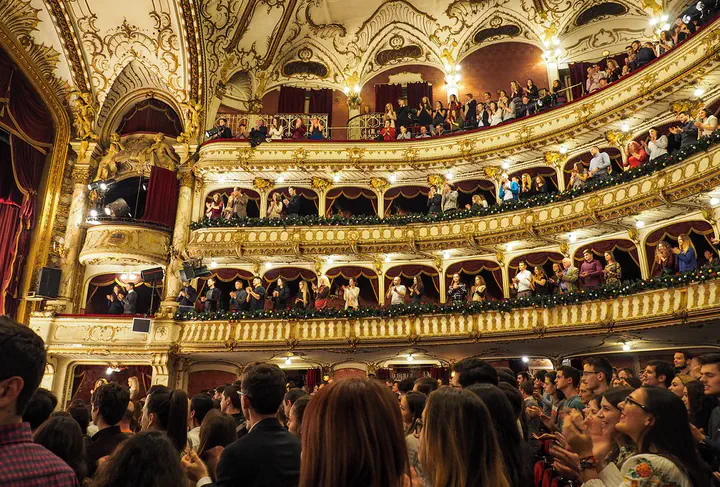Because I got high #1
On the upper register of Western operatic tenors.
 Photo by Vlah Dumitru on Unsplash
Photo by Vlah Dumitru on UnsplashSome over-sophisticated cynics despise the ‘‘cheap’’ thrill that ordinary people like me can get from high notes sung by operatic tenors; but let’s not talk about them in this post. I’m happy to share some of my personal favourites as well as some informal thoughts on the tenor’s voice; I’m actually planning a series of posts on this topic.
When I was a teenager, we had this free CD with opera highlights; and once, I accidentally played it and thought it was utterly boring. And the worst bit was yet to come: a waltz sung in French! For a long-haired heavy metal fan, it doesn’t get more disgusting than that! Anyway, for some unknown reason, the CD played on: Ainsi que la brise légère, soulève un léger tourbillon… This is in the second act of Gounod’s Faust. At one point, a stunning high note left me totally speechless; it was the Swedish tenor Nicolaï Gedda, with his impeccable French diction and his effortless and powerful upper register, singing the high B on je t’aime. This is when my strong liking for this kind of prowess started to develop:
At that time, the Three Tenors’ shows were aired on TV, which contributed quite a lot to popularizing operatic voices. Nessun Dorma, the well-know aria from Giacomo Puccini’s opera Turandot, which had become Luciano Pavarotti’s signature aria, and its final high B, represented for me the epitome of the triumphant tenor’s high note. In this small video where my Obhot lip-syncs to Nessun Dorma, the voice is Pavarotti’s.
In the late 1990s, I was in a university choir and we sang Rossini’s Stabat Mater in St Jean’s Cathedral, Lyon, France. Strictly speaking, this is not opera; but calling the tenor’s aria, Cujus animam gementem, ‘‘operatic’’ is perhaps not an overstatement. Among other difficulties, it features a high D flat, and a very stressful one too, because the soloist sings it with no instrument to support him. The whole choir held their breath. Not just any professional soloist can sing this aria! The excerpt I’ve chosen is also interesting because the tenor, Paolo Fanale, doesn’t really look like a stereotypical opera singer.
Almost by definition, operatic tenors are show-offs. And if a contest were held to pick the tenor who systematically produced longer and higher notes than expected, spread tons of testosterone in his interpretation, and acted like a rock star, the indisputable winner would be Franco Bonisolli. In this short video, he gives his views about the Three Tenors (an absolute must-watch if only for how he mixes Italian, English, French, and German).
The most emblematic tenor’s high note in opera is the high C5, delivered with full power, also known as ‘‘do di petto’’. Tenors fear it; audiences demand it. In Verdi’s Il Trovatore, the tenor aria Di quella pira is very representative of people’s fascination for the high C. Traditionally, tenors sing two high Cs; the funny thing is that Verdi did not write them. In 2000, for the 100th anniversary of Verdi’s death, the conductor Riccardo Muti insisted that the opera be interpreted as Verdi wrote it. So the tenor Salvatore Licitra ended the aria with a G below the high C, and he was immediately booed! An interesting paper on this matter can be found here. Experience has shown that it is better to tune the aria a half (or a whole) step down rather than to omit the high notes.
The Pira was one of Bonisolli’s specialties; quite a few live performances by him are available on Youtube. One of my favourite, illustrating Bonisolli’s eccentric behaviour, is this one, where he apparently fails the high C, gets booed, asks for water, and then totally nails it, triggering a huge round of applause:
Another unwritten high C is often sung in Puccini’s Turandot, in the small passage known as No, no Principessa altera. My first example here features the international superstar Placido Domingo who does not sing the high C. Domingo did not have the most reliable high Bs and Cs, but that did not prevent him from achieving perhaps the most successful career in the history of opera tenors:
Now an example with the high C sung by Franco Corelli. It is not uncommon to read, from people who actually heard him in opera houses, that his voice was more powerful than that of other tenors.
And again, it may sound like the worst caricature of an opera singer, the incarnation of bad taste; but in terms of vocal technique, Franco Bonisolli goes one step beyond and the result is incredibly impressive:
As mentioned earlier, it is not uncommon to transpose difficult areas; but opera legend Giacomo Lauri-Volpi strongly disagreed with this practice. In this video, he sings the high C at age 85 from Che gelida manina (Puccini’s La Bohême), vehemently stresses the obligation to sing in the original key, and invites younger tenors to try and compete with him:
Same aria, this time with another legend: Salvatore Fisichella, aged 70, showing American tenor Andrew Owens how to sing the high C (see how the student is genuinely impressed):
In this post, I have mixed different types of tenor voices (there’s a number of sub-categories). It was meant to be a quick teaser for what’s coming up next in the series. I will focus on more specific aspects next time. There are two additional examples I’d like to share today. The first one is from Verdi’s Rigoletto: these are the final notes from the aria La donna e mobile; Bonisolli overdoes it, but the audience seems to enjoy it and despite the poor quality of the recording, what we can hear is truely amazing:
And here is Salvatore Fisichella in Bellini’s Beatrice di Tenda, with probably one of the most powerful Eb5 you will ever hear from a male voice: